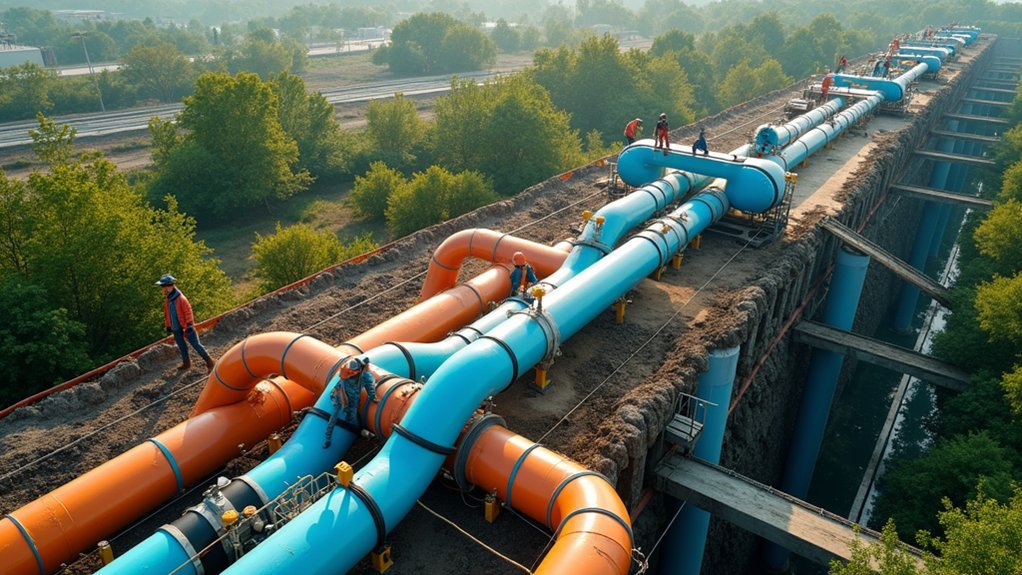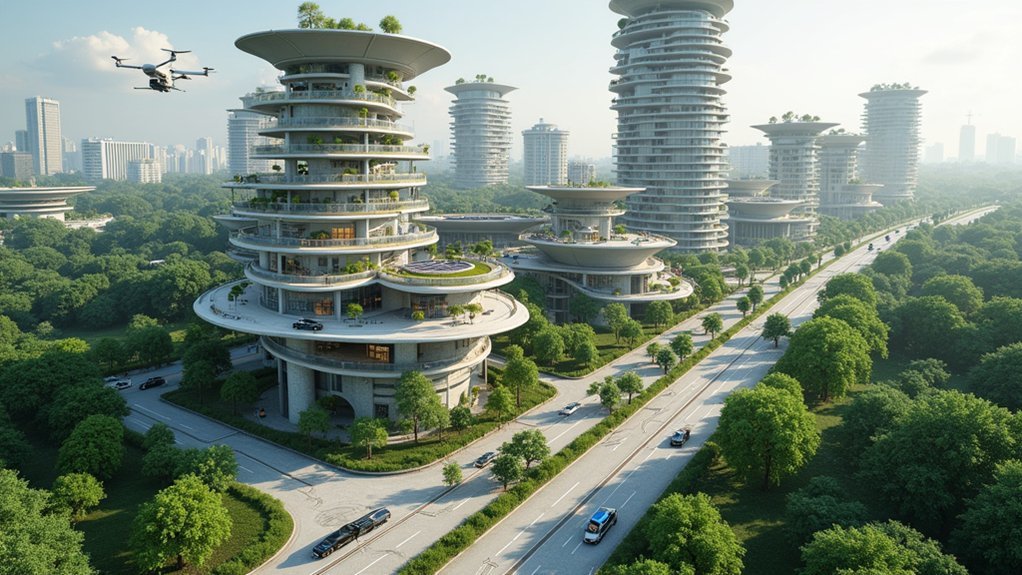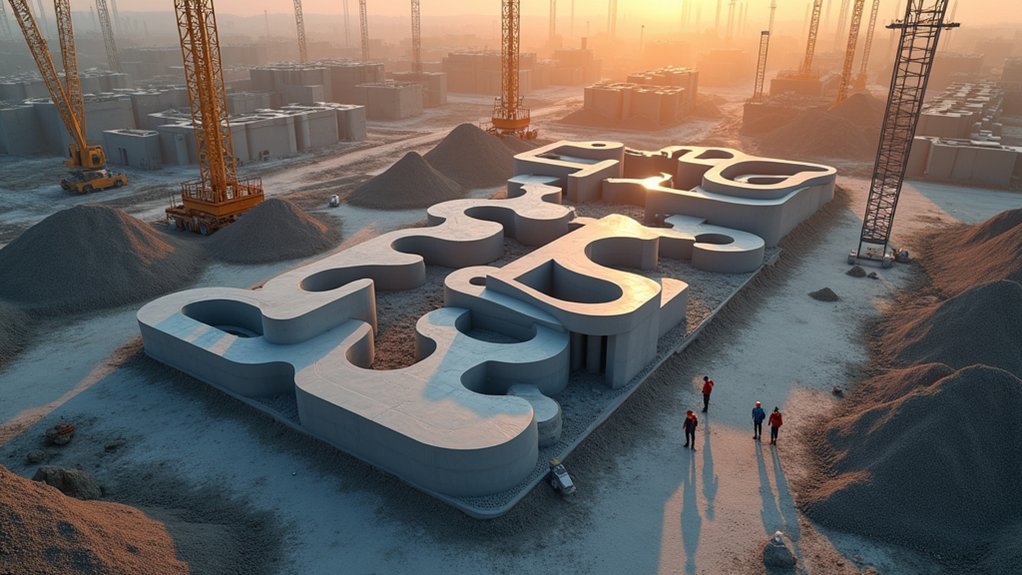You’ll find 3D printing transforming infrastructure construction through rapid bridge fabrication, cutting construction times from months to days while reducing material waste by 60%. This technology enables emergency shelter deployment, custom utility systems, telecommunications towers, and energy infrastructure with up to 80% labor cost reductions. From Shanghai’s concrete pedestrian bridges to smart city components, you can achieve complex geometries impossible with traditional methods. Educational facilities, healthcare infrastructure, and sports complexes benefit from automated processes that enhance efficiency and sustainability while maintaining structural integrity for thorough infrastructure solutions.
Bridge Construction and Engineering Applications

While traditional bridge construction can take months or even years to complete, 3D printing technology revolutionizes the process by enabling rapid fabrication of entire bridge structures in a matter of days or weeks.
You’ll find impressive examples like Shanghai’s 85-foot concrete pedestrian bridge, demonstrating how this technology creates durable structures that meet or exceed conventional performance standards.
With 3D printing, you can achieve complex geometries that enhance both aesthetic appeal and functionality while maintaining structural integrity.
3D printing enables intricate bridge designs that seamlessly blend visual appeal with superior performance and uncompromised structural strength.
Robotic arms and gantry systems make bridge construction possible even in space-limited urban environments.
You’ll benefit from automated processes that reduce labor costs and construction timelines, making 3D printing an increasingly attractive solution for modern infrastructure projects requiring both efficiency and innovation.
Transportation Infrastructure Development
Beyond individual bridge projects, 3D printing transforms entire transportation networks by enabling rapid deployment of essential infrastructure components across highways, railways, and urban transit systems.
You’ll find this technology revolutionizes how transportation infrastructure gets built, delivering structures that match traditional construction strength while cutting material waste by 60%.
Shanghai’s 85-foot concrete pedestrian bridge demonstrates 3D printing’s capability for large-scale transportation solutions.
You can complete projects in days rather than months, utilizing smart design techniques that optimize material use for heavy load resistance.
- Produces durable bridges and tunnels with strength comparable to traditional methods
- Reduces construction timelines from months to days
- Cuts material waste by up to 60% through optimized design
- Creates structures capable of withstanding heavy transportation loads
- Gains regulatory approval in states like Montana for transportation projects
Utility and Water Management Systems

As urban infrastructure demands intensify, 3D printing revolutionizes utility and water management systems by producing complex pipes, valves, and storage tanks with unprecedented design flexibility.
You’ll benefit from rapid prototyping capabilities that create custom fittings and connectors, considerably reducing costs and material waste compared to traditional manufacturing methods.
This 3D printing technology optimizes components for enhanced durability and performance, addressing critical challenges like corrosion resistance and hydraulic efficiency.
You can construct intricate water channel systems and drainage solutions tailored to specific environmental conditions and urban layouts.
The construction process becomes remarkably efficient, reducing installation time by up to 50%.
This acceleration enables quicker deployment of essential infrastructure in rapidly urbanizing areas, making sustainable water management systems more accessible and cost-effective for growing communities.
Public Safety and Emergency Structures
3D printing transforms emergency response capabilities by rapidly constructing life-saving infrastructure when communities face disasters. This printing technology revolutionizes how you build emergency structures, reducing construction time from months to just days.
You’ll find 3D-printed solutions particularly valuable for creating temporary bridges, flood barriers, and emergency shelters that can withstand harsh environmental conditions.
The technology’s customization capabilities allow you to design emergency structures that meet specific local requirements, such as seismic-resistant buildings in earthquake zones.
You’re also contributing to sustainability efforts since 3D printing minimizes material waste while optimizing resource use during critical situations.
- Rapid shelter construction in disaster zones
- Weather-resistant temporary infrastructure deployment
- Customizable designs for regional hazard requirements
- Sustainable material usage reducing environmental impact
- Quick bridge and barrier fabrication for emergency access
Smart City Components and Urban Planning

You can transform your city’s infrastructure by 3D printing intelligent transportation networks that seamlessly connect autonomous vehicles with smart traffic management systems.
Your automated utility systems become more efficient when you manufacture custom sensors, control units, and maintenance components on-demand rather than waiting for traditional suppliers.
You’ll integrate digital infrastructure more effectively by printing specialized housings for 5G equipment, IoT sensors, and data processing units directly into buildings and streetscapes.
Intelligent Transportation Networks
When cities embrace 3D printing technology for transportation infrastructure, they’re revolutionizing how urban mobility systems are designed, built, and maintained.
You’ll find that intelligent transportation systems benefit greatly from customized 3D printed components that adapt to specific environmental conditions, improving durability while reducing maintenance costs.
These sensor-integrated parts enable real-time data collection for traffic management and optimization.
You can implement modular elements that seamlessly integrate into existing frameworks, promoting efficient urban development.
The technology dramatically reduces construction time and costs while maintaining essential performance and safety standards.
- Custom components designed for specific environmental conditions
- Sensor-integrated parts for real-time traffic data collection
- Modular elements for easy integration into existing infrastructure
- Reduced construction time and maintenance costs
- Enhanced durability and performance standards
Automated Utility Systems
As urban populations surge toward unprecedented levels, automated utility systems powered by 3D printing technology are transforming how cities manage their most critical infrastructure.
You can now deploy smart water and energy management components that enhance urban planning efficiency while promoting sustainability. The technology enables rapid construction of utility ducts and conduits, dramatically reducing installation time compared to traditional methods.
With 3D printing, you’ll integrate complex designs for smart city components that improve connectivity and functionality. You can easily customize designs to meet specific utility demands in rapidly growing areas.
These automated utility systems create adaptive structures tailored to your city’s unique requirements. Additionally, 3D printed components reduce material waste by up to 60%, promoting sustainable construction practices in smart city development.
Digital Infrastructure Integration
While traditional urban planning relied on static blueprints and lengthy approval processes, digital infrastructure integration through 3D printing revolutionizes how you’ll design and implement smart city components.
You can rapidly prototype infrastructure designs, visualizing multiple concepts before finalizing projects. This construction method enables you to create smart traffic lights, pedestrian bridges, and public seating that seamlessly integrate technology for enhanced urban functionality.
- Rapid prototyping allows efficient assessment of multiple infrastructure designs
- Smart traffic lights and pedestrian bridges integrate advanced technology systems
- Customized urban utilities adapt to specific environmental and community requirements
- Complex geometric designs enhance functionality and aesthetic appeal of public spaces
- Locally sourced materials reduce waste by up to 60% while promoting sustainability
Telecommunications Infrastructure
You’ll find that 3D printing revolutionizes telecommunications infrastructure by enabling rapid construction of cell towers, reducing both time and labor costs by up to 55%.
The technology excels at producing custom fiber optic housings that withstand harsh environmental conditions while maintaining precise specifications for network components.
You can also leverage additive manufacturing to create equipment shelters on-demand, making network deployment in remote areas considerably more feasible and cost-effective.
Cell Tower Construction
When telecommunications companies need to expand their network coverage rapidly, 3D printing technology transforms cell tower construction from a weeks-long process into one that’s completed in just days.
You’ll find this revolutionary approach addresses critical challenges in the construction industry while delivering superior results for network deployment.
The flexibility of 3D printing allows you to rapidly prototype designs, adapting quickly to changing technological requirements and specific site conditions.
You can build directly on-site, minimizing disruption in urban areas and eliminating logistical headaches from transporting massive components.
- Reduce construction time from weeks to days
- Cut material waste by up to 60% for cost-effective sustainability
- Enable rapid prototyping for flexible design adaptation
- Utilize advanced materials like high-strength concrete for structural durability
- Minimize on-site disruption through direct printing capabilities
Fiber Optic Housings
Thousands of fiber optic installations across telecommunications networks now rely on 3D printed housings that deliver unprecedented customization and protection for delicate cable systems.
You’ll find that 3D printing technology enables manufacturers to create complex geometries tailored to specific telecommunications requirements, ensuring peak support in diverse environments.
When you compare printing methods to traditional construction methods, you’ll discover significant advantages in both time and cost efficiency.
You can achieve rapid prototyping and production with substantially reduced lead times. The cost savings you’ll experience can reach up to 60% through reduced material consumption and labor requirements.
You’ll also benefit from sustainable manufacturing practices that minimize waste and support local material sourcing, making your telecommunications infrastructure projects more environmentally responsible while maintaining superior durability and performance standards.
Equipment Shelter Manufacturing
Beyond traditional fiber housing applications, 3D printing transforms equipment shelter manufacturing by delivering robust, weatherproof structures that protect critical telecommunications hardware.
You’ll find these shelters printed using concrete or composite materials directly on construction sites, offering superior durability against extreme weather conditions. The additive manufacturing process lets you customize designs to accommodate specific equipment layouts and spatial requirements.
- Reduce construction time by up to 50% for faster service deployment
- Cut material waste by 60% compared to traditional building methods
- Print shelters onsite using durable concrete or composite materials
- Customize designs for specific telecommunications equipment configurations
- Deploy rapidly in both urban and rural locations
This technology enables cost-effective, sustainable solutions while accelerating telecommunications infrastructure development across diverse environments.
Energy Infrastructure and Renewable Systems
As renewable energy demands surge worldwide, 3D printing technology transforms how you’ll approach energy infrastructure development.
You can now produce wind turbine bases and solar panel supports with unprecedented customization for site-specific conditions while accelerating construction timelines.
When implementing 3D printing for energy infrastructure projects, you’ll reduce material waste by up to 60% compared to traditional methods.
This technology enables you to create complex geometries for biogas plants and geothermal systems that enhance operational efficiency and performance capabilities.
You’ll benefit from rapid prototyping capabilities that allow quick testing of innovative designs tailored specifically for renewable energy applications.
Most notably, you can decrease labor costs by up to 80%, dramatically reducing overall project expenses while maintaining quality standards.
Waste Management and Environmental Solutions
While environmental concerns intensify across construction sectors, 3D printing technology revolutionizes how you’ll tackle waste management challenges and implement sustainable building solutions.
3D printing technology transforms construction waste management, enabling sustainable building solutions as environmental concerns escalate across the industry.
You can now transform recycled materials like plastic and concrete debris into new building components, dramatically reducing landfill waste while promoting circular economy principles. This innovative approach minimizes your construction’s carbon footprint since 3D printing processes require considerably less energy than traditional methods, enhancing environmental sustainability.
- Utilize recycled waste materials to create durable building components
- Reduce construction waste by up to 60% through precise printing techniques
- Develop bio-bricks from organic waste for dual environmental benefits
- Integrate local soil and waste byproducts for context-specific sustainable construction
- Lower energy consumption compared to conventional building methods
Commercial and Industrial Facilities
You’ll find 3D printing revolutionizing how commercial and industrial facilities come to life, cutting construction timelines by months while slashing labor costs up to 80%.
Whether you’re planning office buildings that need customized layouts or massive warehouses requiring rapid deployment, this technology lets you build faster and more efficiently than traditional methods.
You can now respond to market demands with unprecedented speed, getting your facilities operational while competitors are still pouring foundations.
Office Building Applications
When businesses consider constructing new office buildings, 3D printing technology offers remarkable advantages that transform traditional commercial development timelines.
Construction companies can now deliver projects with unprecedented speed and cost-effectiveness, reducing labor expenses by up to 80% while maintaining high-quality standards.
You’ll benefit from 3D printing’s ability to create diverse architectural designs that meet specific commercial requirements.
The technology enables smart material usage, optimizing structural efficiency while lowering overall construction costs.
- Rapid construction reduces build times compared to traditional methods
- Labor cost reductions of up to 80% streamline project budgets
- Scalable technology accommodates various building sizes and specifications
- Smart designs enhance material efficiency and reduce waste
- Faster completion allows quicker occupancy in busy commercial areas
Warehouse and Manufacturing
Beyond office spaces, 3D printing technology revolutionizes warehouse and manufacturing facility construction with even greater impact on industrial operations.
You’ll complete structures in just days rather than months, dramatically accelerating your project timelines. Construction printing reduces your labor costs by up to 80% while cutting material waste by 60%, delivering substantial savings for large-scale facilities.
You can customize designs to meet specific operational requirements, creating complex geometries impossible with traditional methods.
The technology’s scalability lets you adapt plans quickly for varying facility sizes without delays. By utilizing local materials, 3D printing promotes sustainable practices and reduces your carbon footprint from material transportation, making it an environmentally responsible choice for industrial construction.
Educational and Public Building Construction
As student enrollment surges worldwide, 3D printing technology offers a revolutionary solution for rapidly constructing educational facilities that meet growing infrastructure demands.
You’ll find this innovative approach transforms how schools and universities are built, delivering structures in record time while maintaining quality standards.
Public buildings like community centers and libraries also benefit greatly from 3D printing construction methods.
3D printing revolutionizes public infrastructure construction, enabling communities to rapidly build libraries and centers with enhanced efficiency and reduced costs.
You can achieve substantial cost reductions through material efficiency, with waste decreasing by up to 60%.
The technology’s design flexibility enables you to create engaging architectural features that enhance learning environments.
- Rapid deployment addresses urgent educational infrastructure needs
- Construction time reduces dramatically compared to traditional methods
- Design flexibility creates unique, engaging architectural features
- Material waste decreases up to 60%, improving cost efficiency
- Sustainable solutions benefit developing regions globally
Healthcare and Medical Facility Infrastructure
While traditional hospital construction can take years to complete, 3D printing technology revolutionizes healthcare infrastructure by delivering critical medical facilities in a matter of weeks.
You’ll find this rapid construction capability essential during public health emergencies when time saves lives.
The construction market benefits from 3D printing’s customizable approach, allowing you to design modular clinics and emergency response units that meet specific operational requirements.
You can create specialized spaces like operating rooms and recovery areas tailored for efficiency and patient comfort.
Cost savings reach up to 30% compared to traditional methods, letting you redirect funds toward medical services.
Beyond facilities, 3D printing enables you to produce medical equipment, surgical tools, and prosthetics, supporting both infrastructure development and patient treatment simultaneously.
Sports and Recreation Facility Development
3D printing technology transforms sports and recreation facility development by enabling architects to create complex, custom designs that serve specific community needs.
This printing construction method dramatically reduces build times, with stadiums and sports complexes completing in fractions of traditional timelines while achieving lower labor costs through automated processes.
You’ll find 3D printing particularly valuable in urban areas where space optimization matters most.
The technology reduces material waste by up to 60%, promoting sustainable building practices across recreational projects.
Notable examples include 3D-printed soccer field stands and training facilities that demonstrate durability and aesthetic appeal.
- Enables complex architectural designs tailored to community preferences
- Reduces construction time compared to traditional building methods
- Cuts material waste by up to 60% for sustainable practices
- Provides innovative solutions for densely populated urban areas
- Creates durable, aesthetically pleasing recreational structures
Frequently Asked Questions
What Are the Applications of 3D Printing in Construction Industry?
You’ll find 3D printing creates bridges, road barriers, utility buildings, and modular components. You’re reducing construction time, cutting costs by 60%, minimizing waste, and building complex geometries that withstand heavy loads efficiently.
What Are the Methods Used for 3D Printing for Construction?
You’ll use extrusion methods with robotic arms or cranes, powder bonding techniques, gantry systems for large-scale printing, and spray methods. These approaches let you create complex geometries and detailed finishes efficiently.
Where Is 3D Printing Used in Construction?
You’ll find 3D printing used in highways, bridges, warehouses, data centers, pedestrian walkways, wastewater treatment plants, and transportation systems like tunnels and transit stations for faster, cost-effective construction.
How Has 3D Printing Been Used in the Construction Industry?
You’ve seen 3D printing revolutionize construction through bridges like Shanghai’s 85-foot pedestrian structure, net-zero homes by Mighty Buildings, and rapid residential projects completed in just 24 hours using advanced printing technologies.





Leave a Reply